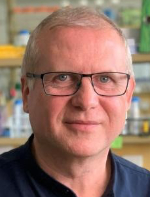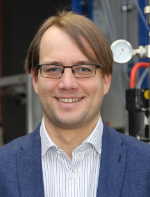Our research fields
Biocatalysis & chemical analytics
This research field describes the use of biocatalysts for the conversion and synthesis of molecules and to replace common chemical processes by efficient and environmental-friendly approaches. So far, numerous processes have been industrially implemented in single reaction format. Now, time has come for the development of multistep-onepot reactions, which would allow to reduce the number of working steps for processing and the purification of intermediate reaction products that cause a significant amount of CO2 emissions.
Enzyme technologies & protein engineering
In this research field we are dealing with new enzymatic conversions within synthetic approaches in order to close current gaps in enzymatic process applications. A special focus is on the optimization of enzymes for industrial approaches. Especially, in multistep-onepot reactions, enzymes have to meet industrial requirements regarding specificity, stability and productivity. Appropriate enzyme variants are screened, and their production process is optimized. Knowledge about enzyme characteristics is necessary for optimization using (semi)-rational engineering methods.
Microbial biotechnology
The research field includes the biotechnological utilization of microorganisms (bacteria, yeasts, fungi) and their compartments. The new methods and concepts of synthetic biology are used in order to reach the following objectives:
- Making use of genetic diversity of microbial strains to increase the productivity and robustness of production strains
- Development and characterization of standardized and customized elements for the systematic strain development of yeasts and fungi
- Development of “carbon capture and utilization” technologies to convert CO2 into high-value products biotechnologically
- Development of microbial populations (named microbiomes) for biologic plant protection

Prof. Diethard Mattanovich
Cell line development & epigenetics
The projects carried out in this area deal with a detailed, molecular understanding of the properties of production cells that are used for manufacturing biopharmaceutical products. These include, above all, higher cell lines obtained from mammals, humans, or plants, which can produce therapeutic proteins of a quality which is suitable for injection into patients. In addition to therapeutic proteins, these cells can also be used to produce viruses and virus-like particles that are applied in vaccines or gene therapy.
The research aims at optimizing the efficiency of cells so that higher yields are possible at highest quality, while at the same time reducing costs and necessary timelines. In particular, new technologies are to be developed which, with the help of systems biology and the analysis of genetic and epigenetic regulatory mechanisms in cells, improve the properties of cells for production and in the industrial bioprocess.

Prof. Nicole Borth
Bioinformatics & simulations
Genes, RNA, proteins, and metabolites are the key players in biological systems. The sum of these parts is less than the whole because these actors never act alone, but are integrated into complex and multi-layered networks. The decoding of these networks and their structures as well as the interactions between them is therefore essential for an understanding of biological processes.
The aim of the research is not only to decipher these network interactions with mathematical methods, but also to enable targeted influencing, control and monitoring of these networks on all cellular levels as well as on the levels of the bio-process (especially in the upstream and downstream area). This makes it possible to design and optimize biological cell factories in a targeted and rational way on the drawing board, which enable the sustainable production of chemical raw materials.

Prof. Jürgen Zanghellini
Bioprocess technologies
The research area Bioprocess Technologies deals with the development of improved or new biotechnological processes, control, and regulation algorithms. The aim of the research area is to obtain the most comprehensive possible understanding of biotechnological processes and to enable their application in the biopharmaceutical and biotechnological industries in general. By implementing new processes / technologies and control and regulation strategies, the manufacturing costs, and the time to market entry of a biopharmaceutical product can be reduced. The research area is particularly dealing with:
- Development of production processes for bionanoparticles (eg viruses and virus-like particles VLP)
- Scalability of processes and their transferability from laboratory to industrial scale
- Modelling and simulation of biotechnological processes as a basis for automation
- Development of new materials for biotechnological applications
- Development of new (continuous) processes for the purification of proteins as Exploration of interaction between proteins and surfaces

Prof. Alois Jungbauer
Bioeconomy & environmental biotechnology
Optimizing recycling and recycling processes has been one of acib’s key issues for a long time. Only a small part of all plastic waste is recycled; Huge amounts end up in the environment, where they are degraded very slowly. The aim is to optimize these processes to create a natural recycling process in the long term.
Microbial enzymes play an important role in this. One focus is the design of new enzymes with improved and, above all, tailored activities towards (bio)polymers. In addition to the processing of (bio)polymers in large quantities, polymer-active enzyme reactions for new pharmaceutical strategies in connection with abusive opioid formulations are also being investigated.
In addition, modern metagenomic techniques are used to identify even non-cultivable microbes and their enzymes, and bacterial cell systems are investigated which, after exposure to certain human biomarkers, release intracellular indicator molecules, which subsequently lead to color reactions.


